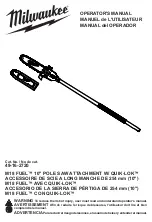
45
VIII. Cutting
DANGER!
To reduce the risk of injuries, respect the following safety regulations during any
kind of processing:
- use personal safety equipment;
- saw only one piece at a time;
- when cross cutting, always press the workpiece against the workbench;
- do not slow down the saw blade by exerting a side pressure on it;
- For all kinds of work and according to your necessities always use:
+ a pusher if the distance between the rip fence and the saw blade is less
than or equal to 120 mm;
+ a support surface for long pieces if they risk to fall from the workbench
after being cut;
+ a dust collection device;
+ a suitable locking device, in order that the piece cannot rotate crosswise.
+ a square with suitable stops to prevent the piece from bending.
Maintain a correct working position when using the machine (saw blade’s teeth must
point towards the operator and downwards).
Do not pile the pieces to cut them. If they get caught by the blade uncontrollably risks
may arise for the operator.
Never cut pieces fastened with ropes, strings, cables or wires, or containing these
materials.
1. Be sure of the perfect conditions of the saw blade and of the protection devices.
2. If necessary, adjust workbench’s inclination.
3. Place the rip fence according to the type of cutting you want to carry out, or choose the
outline of the support for the piece to be cut.
4. Position and lock the upper blade guide at a distance of 3 mm over the workpiece.
5. Select blade speed.
6. Before starting working, do a shear test on a piece.
7. Connect the bandsaw to the power supply and switch on the machine.
8. Place the piece on the workbench.
9. Cut one piece at a time.
10. Once you have finished cutting, switch off the machine, disconnect from the power
supply and clean it.












































